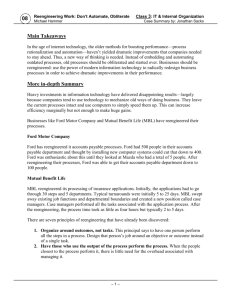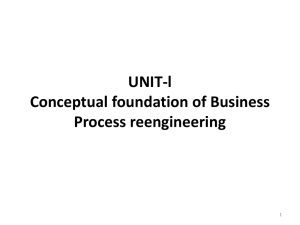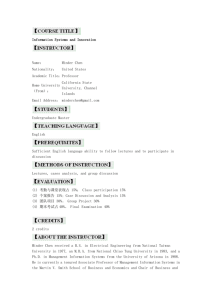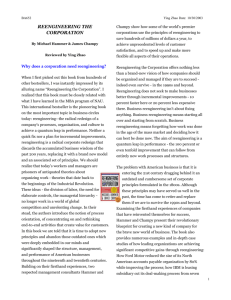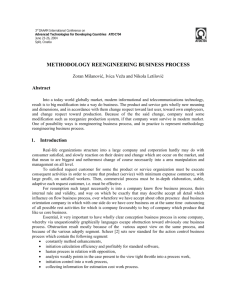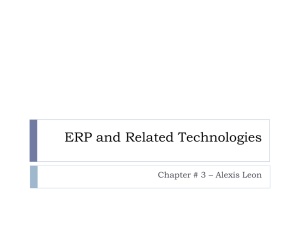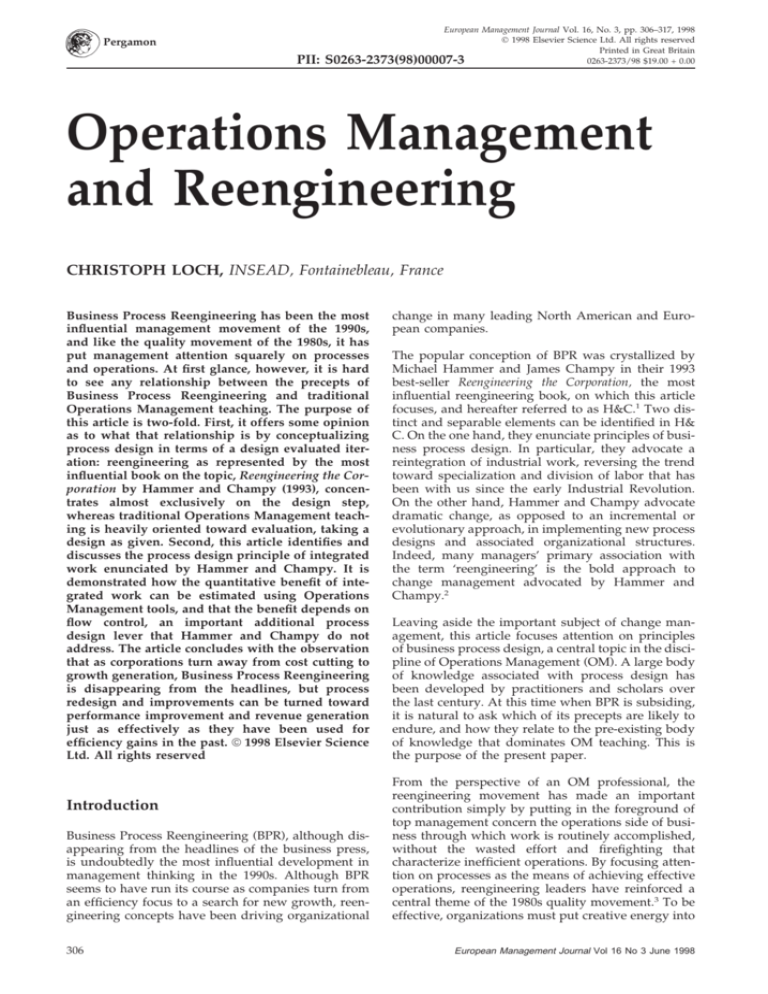
Pergamon
PII:
European Management Journal Vol. 16, No. 3, pp. 306–317, 1998
1998 Elsevier Science Ltd. All rights reserved
Printed in Great Britain
S0263-2373(98)00007-3
0263-2373/98 $19.00 + 0.00
Operations Management
and Reengineering
CHRISTOPH LOCH, INSEAD, Fontainebleau, France
Business Process Reengineering has been the most
influential management movement of the 1990s,
and like the quality movement of the 1980s, it has
put management attention squarely on processes
and operations. At first glance, however, it is hard
to see any relationship between the precepts of
Business Process Reengineering and traditional
Operations Management teaching. The purpose of
this article is two-fold. First, it offers some opinion
as to what that relationship is by conceptualizing
process design in terms of a design evaluated iteration: reengineering as represented by the most
influential book on the topic, Reengineering the Corporation by Hammer and Champy (1993), concentrates almost exclusively on the design step,
whereas traditional Operations Management teaching is heavily oriented toward evaluation, taking a
design as given. Second, this article identifies and
discusses the process design principle of integrated
work enunciated by Hammer and Champy. It is
demonstrated how the quantitative benefit of integrated work can be estimated using Operations
Management tools, and that the benefit depends on
flow control, an important additional process
design lever that Hammer and Champy do not
address. The article concludes with the observation
that as corporations turn away from cost cutting to
growth generation, Business Process Reengineering
is disappearing from the headlines, but process
redesign and improvements can be turned toward
performance improvement and revenue generation
just as effectively as they have been used for
efficiency gains in the past. 1998 Elsevier Science
Ltd. All rights reserved
Introduction
Business Process Reengineering (BPR), although disappearing from the headlines of the business press,
is undoubtedly the most influential development in
management thinking in the 1990s. Although BPR
seems to have run its course as companies turn from
an efficiency focus to a search for new growth, reengineering concepts have been driving organizational
306
change in many leading North American and European companies.
The popular conception of BPR was crystallized by
Michael Hammer and James Champy in their 1993
best-seller Reengineering the Corporation, the most
influential reengineering book, on which this article
focuses, and hereafter referred to as H&C.1 Two distinct and separable elements can be identified in H&
C. On the one hand, they enunciate principles of business process design. In particular, they advocate a
reintegration of industrial work, reversing the trend
toward specialization and division of labor that has
been with us since the early Industrial Revolution.
On the other hand, Hammer and Champy advocate
dramatic change, as opposed to an incremental or
evolutionary approach, in implementing new process
designs and associated organizational structures.
Indeed, many managers’ primary association with
the term ‘reengineering’ is the bold approach to
change management advocated by Hammer and
Champy.2
Leaving aside the important subject of change management, this article focuses attention on principles
of business process design, a central topic in the discipline of Operations Management (OM). A large body
of knowledge associated with process design has
been developed by practitioners and scholars over
the last century. At this time when BPR is subsiding,
it is natural to ask which of its precepts are likely to
endure, and how they relate to the pre-existing body
of knowledge that dominates OM teaching. This is
the purpose of the present paper.
From the perspective of an OM professional, the
reengineering movement has made an important
contribution simply by putting in the foreground of
top management concern the operations side of business through which work is routinely accomplished,
without the wasted effort and firefighting that
characterize inefficient operations. By focusing attention on processes as the means of achieving effective
operations, reengineering leaders have reinforced a
central theme of the 1980s quality movement.3 To be
effective, organizations must put creative energy into
European Management Journal Vol 16 No 3 June 1998
OPERATIONS MANAGEMENT AND REENGINEERING
the design, documentation and maintenance of processes that satisfy customer needs on a routine basis.
Workers must understand the overall function of
core business processes, and performance must be
measured in terms of value delivered to customers.
It seems, however, that BPR has illuminated some
parts of the OM landscape while leaving other parts
in shadow. In their treatment of process design, all
of the influential books and articles cited earlier use
vague language and lack cause-and-effect reasoning.
In addition, their recommendations implicitly
depend on a critical element of process design,
namely intelligent flow control, but they never
acknowledge it as a separate category of design levers.
The next section summarizes what Harrison (1997)
calls the ‘processing network paradigm,’ a general
process model that underlies much of OM teaching
and from which one obtains precise language, causal
reasoning, and analytical procedures to support process design. Section 3 summarizes the main precepts
of BPR and explains, using the language of the processing network paradigm, how BPR and OM complement each other, while differing in both emphasis
and texture. The last section of the paper demonstrates, in the example of integrated work, the benefit
of flow management protocols and the usefulness of
OM tools to estimate their value.
A Conceptual Framework of Business
Process Design
To evaluate principles of process design, one needs
to understand the causal relationship between design
choice and bottom-line performance. For this kind of
cause-and-effect reasoning, one first needs a vocabulary to describe business processes, including generic
names for the elements that make up a process. Furthermore, any design problem worthy of discussion
involves tradeoffs, whether it is a mouse trap or a
business process that is being designed. Designers,
therefore, invariably need to balance factors or objectives which cannot be achieved simultaneously.
To address these needs, operations management
practitioners and scholars have developed over many
decades a collection of generic process models and
associated analytical techniques.4 In this paper they
will be referred to collectively as ‘processing network
models,’ and their common structure will be called
‘the processing network paradigm,’ following Harrison (1997).
A process design in this paradigm consists of five
basic elements – jobs, tasks, precedence constraints,
resources, and flow management protocols. A sixth
element will be proposed below. First, in this terminEuropean Management Journal Vol 16 No 3 June 1998
ology the units to be processed are called jobs. Jobs
are the entities that ‘flow’ through a process, and a
single process may need to handle a variety of job
types. As a second basic concept in the processing
network paradigm, jobs are made up of tasks. In
particular contexts, jobs might be called, for example,
transactions, manufacturing orders, projects, or customers, and tasks are frequently referred to as activities or operations. Tasks are connected by precedence
relations, that is to say, some tasks must be completed
before others can be started.
Jobs, tasks and their precedence relationships can be
represented in a conventional flow chart. Figure 1
shows the example of a flow chart of the product
development process at ConnectCo, a manufacturer
of electrical connectors. This example is described in
detail in Adler et al. (1995, 1996). Jobs are development projects, tasks are depicted by boxes and precedence relationships by arrows in Figure 1. Precedences may be uncertain due to unforeseeable
events: in the example, prototyping must be repeated
in 75 per cent, and scale-up plus prototyping in 60
per cent of all cases because the design poses manufacturing problems which can be planned statistically, but not for an individual job.
The third basic element of a processing network
model is a set of system performance criteria, which
describe what the desired output of the process is (in
Figure 1, it is new connector products), and how one
can tell whether the process does well or not. Typical
performance measures comprise a combination of:
volume or frequency (e.g. 12 new products per year),
throughput time (e.g. time-to-market of under
12 months on average), service level (with 90 per cent
evidence, one can promise a new product in under
18 months), or costs (the whole process costs less
than $10 M per year).
Together, the first three elements describe what the
process should accomplish, namely its output as well
as the work that needs to be performed in order to
produce the output. In order to specify a complete
process design, one must also determine how the
work is to be performed. This is specified by
resources, a flow management protocol and system
status information.
Processing resources are the units that execute the
tasks, which make up the jobs. At ConnectCo the key
resources are groups of development engineers and
technicians. Resources are characterized by capabilities, such as the breadth of job types they can process,
or whether they need to be supervised by other
resources. For example, engineers have a wider range
of capabilities and can work more independently
than technicians, but they are also more expensive.
The fifth element of a process specification is a flow
management protocol, the simplest example of which
is a route, corresponding to a fixed order in which
307
OPERATIONS MANAGEMENT AND REENGINEERING
Figure 1
The Process Flow Chart
resources execute a job’s constituent tasks. In general,
however, management may have a great deal of latitude in assigning a job’s tasks to different resources
and the order in which tasks associated with different
jobs are processed at a given resource. This may
depend on job type and urgency, resource availability, or system status in general. Sophisticated
flow control may require system status information,
such as which jobs are where in the system, or which
resources are busy or idle.
An important point to bear in mind is that tasks,
resources and flow protocols are not independent.
Assigning several tasks to one resource, or operating
in a high-variability processing system, may require
higher resource capabilities (such as cross-training, or
universal processing machines). Dynamic flow protocols with tasks assigned to resources depending on
the job type may even introduce new tasks, for coordination and monitoring, or for tracking system
status information.
With the above five elements of the processing network model, the work which is to be accomplished
and how it is to be done can be determined. Traditionally, OM regarded this specification as complete, implicitly viewing the processing resources as
machines (see, for example, the characterization by
Buzacott, 1996, p. 768) or as piece workers whose performance can be ‘designed.’ Recently, however,
incentive issues have been incorporated into OM from
organizational theory and economics, reflecting the
realization that work cannot be monitored perfectly
and that employee performance is heavily influenced
by incentives and accountability. An example is the
global coordination of supply chains by making
upstream parties responsible for downstream
(‘echelon’) inventories (e.g. Lee and Billington, 1992).
Incentives may even need to sacrifice some shortterm performance of a process in order to ensure
long-term improvement and employee motivation.
For example, at Microsoft the customer help desk is
308
an important entry level job, which thus needs to
attract employees with high future development
potential. Ensuring the motivation and career development of such employees requires a higher investment than may be necessary for short-term process
efficiency. In the light of these considerations, we
propose a system of assessing individual contributions as
the final element of a process design.
These six elements provide a complete process design
specification. A second step in process design is evaluating the proposed specification. Analogous to design
prototype iterations in engineering (see Wheelwright
and Clark, 1992, chap. 10), the cycle must be repeated
until the evaluation indicates satisfactory performance. The process design cycle is summarized in Figure 2.
The first question one may be prompted to ask in
evaluating a process specification is whether a given
set of resources provides enough capacity to satisfy
a given set of external demand rates on a sustained
basis. An affirmative answer requires that total
capacity consumption for each processing resource
be less than or equal to the total capacity available.
To estimate resource consumption rates, one needs
to know the tasks involved in each type of job and
the resources to which these tasks are assigned, but
the ordering of the tasks is immaterial.
Resource consumption rates should include all nonproductive time that is usage-driven, such as
resource hours consumed in setups and in rework.
Similarly, resource availability rates must be properly
deflated to account for non-productive time that is
not usage-driven, such as operator breaks and preventive maintenance. Assessing whether capacity is
sufficient to satisfy a specified demand vector is often
called rough-cut capacity analysis.
To understand where capacity is most scarce, one calculates the total capacity consumed as a percentage
of the capacity available for each processing resource,
European Management Journal Vol 16 No 3 June 1998
OPERATIONS MANAGEMENT AND REENGINEERING
Figure 2 The Iterative Cycle of Process Design
based on a particular demand scenario. This ratio is
called ‘utilization’, and by the above description it
includes time consumed in non-productive activities
like rework and setups. By breaking total utilization
into its constituent parts one obtains a utilization profile of the resources. Resources for which the utilization rate is highest are often called process bottlenecks.
The second question to ask in evaluating a process
specification involves the effects of variability on performance. A crucial aspect of the processing network
paradigm is the conception of work as a flow of jobs
over time. Jobs are not processed in isolation, but
arrive in an overlapping way, with the pattern of
arrivals depending on many factors, some controllable and some not. It is an unfortunate fact of life
that demand for products and services varies hourly,
daily, and seasonally. Moreover, in most cases the
tasks required for the completion of a job are not
completely foreseeable, as is evident in the ConnectCo example above. Jobs may have to compete for
resources during periods when demand is high or
processing is unexpectedly slow. Variability
degrades system performance by leading to queuing
delays and inventories, or to lost throughput, both of
which are a focus of attention in OM teaching.
Queuing delays extend the total time that a job
spends within a processing network, referred to hereafter as its overall throughput time. In cases where jobs
represent requests or orders from customers, long
throughput times obviously represent poor service,
and in make-to-stock manufacturing they hinder
rapid response to changing market conditions, leading to stockouts and high inventory costs. It should
be emphasized that throughput time is itself highly
variable in most processing networks, and its average
is seldom an adequate measure of responsiveness. In
European Management Journal Vol 16 No 3 June 1998
other words, the throughput time or response time
of a business process must be considered as a distribution, a range of values with associated probabilities,
and the mean of that distribution is seldom a satisfactory summary of process performance. For example,
in make-to-order manufacturing, a manager may
wish to ensure that a particular promised lead time
is achieved with 95 per cent reliability, in which case,
concern centers on the 95th percentile of the throughput time distribution, not on its mean.
Once utilization profiles and variability are understood, the performance of a process can be evaluated.
Work flow performance modeling has been a dominant concern of OM, and a large set of sophisticated
tools for performance evaluation, such as capacity
modeling (e.g. linear programming) and flow modeling (e.g. queuing models, simulation), is available.
However, a number of qualitative process specification principles have also emerged, centering on
reducing utilization and reducing variability, which we
summarize in Table 1. These are now well accepted,
not only in manufacturing (Hopp et al., 1990), but
also in services (Fitzsimmons and Fitzsimmons, 1994)
and product development (Adler et al., 1995, 1996).
We concentrate on process design for response time
performance, which is also the emphasis of most
examples in H&C.
The New Conventional Wisdom of
Business Process Design
In this section, we briefly summarize H&C’s view of
process design in their own words. We then show
that their process design principles are consistent
with the specification design step of the processing
network paradigm.
309
OPERATIONS MANAGEMENT AND REENGINEERING
Table 1
Process Design Principles for Response Time Improvement
Specification Step
What?
Jobs (taking volumes as given)
Task structure
How?
Resources and capabilities
Design Principle
Reduce variability: Demand: reduce peaks, negotiate with customers to make demand
more regular, processing: product/service standardization, variant reduction
Reduce utilization: remove steps through design-to-manufacture (DFM), or design-forlogistics, eliminate activities through automation (e.g. IT support)
Reduce variability: standard operating procedures (SOPs), in product development
separation of research and development or reliance on proven technologies
Reduce utilization: add resources, involve workers (e.g., reduce absenteeism and
turnover), make capacity more flexible (e.g., overtime)
Reduce variability: statistical process control (SPC), quality circles and worker training
Reduce both: minimize scrap, set-ups and breakdowns (e.g. preventive maintenance),
material shortages (e.g. supplier certification), provide timely information and standard
procedures through IT;
Pool (make resources interchangeable) in order to equalize resource utilizations
(however, this may reduce efficiency or increase system variability)
Flow management protocols
Smooth production flows, in just-in-time processing (JIT)
Schedule around bottlenecks to increase effective bottleneck capacity
Sequence work with the shortest processing time first (SPT rule), or use priorities to
concentrate congestion on ‘background work’, or sequence and route jobs based on
system status reporting systems (toward resources that are idle or not congested)
Incentives
Make upstream party (e.g. production) responsible for effects of decisions on
downstream (e.g. inventories) to increase global system performance
H&C formulate four general themes of reengineering
in Chapter 2: process orientation, the creative use of
Information Technology (IT), ambition, and rulebreaking. We focus on the first two themes, which
are concerned with process design, leaving aside the
latter two, which are associated with change management. Chapter 3 formulates nine principles of reengineered (or ‘re-thought’) processes. Chapter 4
describes how the authors believe their process
design principles will influence the ‘nature of work,’
namely worker capabilities, performance measurement and values. Chapter 5 argues that IT enables
the implementation of the new process and work
characteristics, by making information available in a
decentralized way and by automating routine tasks.
Re-thought processes and the new world of work are
referred to as ‘process orientation’ and summarized
in Figure 3.
Chapter 4 contains the essence of H&C’s process
design principles (for the detailed descriptions, we
refer the reader to pp. 51–64). The principle of process steps performed in their natural order refers to
following the ‘natural work precedence rather than
the artificial one introduced by linearity.’ Reduced
checks and controls are achieved by replacing
detailed controls by aggregate (and thus fewer) ones
as long as it is economical, ‘allowing limited abuse.’
Minimizing reconciliation aims to reduce the external
contact points of a process, reducing the risk of inconsistent data being received. Task combination assigns
310
several tasks to one worker (resource), thus eliminating handoffs.5 ‘Workers making decisions’ integrates
formerly managerial activities into everyone’s work
by delegating a certain degree of decision-making.
Multiple process versions separate jobs into ‘standard’ and ‘hard’ cases through ‘triage’ and then process these separately. Having work done ‘where it
makes the most sense’ shifts activities, even across
organizational boundaries, to customers and suppliers whenever efficiencies can be gained. Hybrid
centralization/decentralization allows local decisionmaking (e.g. sales contracts signed on the spot), while
at the same time maintaining global information
updates and control. Finally, the case manager provides a single co-ordinating interface to the customer,
behaving ‘as if he/she were responsible for the whole
process, even though that is not the case.’
The ‘new world of work’ refers to ‘implications (of
fundamental changes in business processes) for many
other parts and aspects of an organization’ (p. 65).
These implications are in the organization (flatter and
process- rather than functional-oriented), the workers’ capabilities, performance measurement, and the
organization’s culture and values. It is, however, misleading to view these changes only as results of process reengineering; they are at the same time essential
enablers of reengineered processes. Workers cannot
perform integrated work or make decisions without
first acquiring the capabilities to take on the
additional functions. Similarly, without appropriate
European Management Journal Vol 16 No 3 June 1998
OPERATIONS MANAGEMENT AND REENGINEERING
Figure 3 H&C’s Principles of Process Design
customer-oriented performance measures that relate
an individual’s activities to the overall process purpose, workers may revert to pursuing narrow and
possibly dysfunctional goals. Finally, in a decentralized process with delegated decision power, it is
impossible to fully monitor everyone’s individual
contribution. If culture and values do not support
responsible behavior, decentralization and delegation
may lead to prohibitive abuse. Indeed, H&C introduce the business diamond (p. 80), where process
design, jobs, performance measurement, and values
are depicted as forming an iterative cycle.6
How, then, do H&C’s process design principles relate
to OM and the processing network paradigm? In Figure 4, we group H&C’s principles (excluding the IT
enablers) under the process specification questions
from Figure 2. The first three principles relate to
defining a task structure, such as performing steps in
a natural (e.g. parallel) order. We also find principles
about upgrading resource capabilities, assigning
tasks to resources (e.g. combining tasks and
delegating), system status information (hybrid centralization via IT), and performance measurement.
The case manager also relates to the processing network paradigm, but in a more complicated way by
combining several elements from Figure 2. The task
structure is altered by adding explicit coordination
tasks (for the benefit of the inquiring customer). A
dedicated resource is created for these tasks, with the
authority to impose situation-specific flow protocols.
For example, the case manager may determine that
a certain individual customer order is so important
that it needs to be given preemptive processing priority over all other jobs. This process is complicated,
and possibly more costly, but very flexible in reacting
to specific customer needs.
It becomes clear that the principles in the first six catEuropean Management Journal Vol 16 No 3 June 1998
egories in Figure 4 harmonize with the process specification step in Figure 2, but they are more ‘general’
than the OM design principles formulated in Table
1. H&C’s principles mainly relate to the left-hand
step of the process design iteration in Figure 2. Thus,
BPR is heavily oriented toward process specification,
but has little to say about process design evaluation.
On the other hand, the BPR principles of values and
culture, as well as the shape of the organizational
structure, are outside the processing network paradigm. They are clearly important since organizational
structure may influence the ease of co-ordination
across units, and values may impact how well workers are willing to perform without being monitored.
Traditionally, these issues have not been examined
within the field of OM.
Based on this comparison between H&C’s process
design principles and the processing network paradigm, we come to the conclusion that BPR has made
a very important contribution to the specification
aspects of process design. First, BPR has elevated
process management and operations to the attention
of top management. Scholars and practitioners in
strategy and organizational behavior have adopted
the concept of a process in their thinking.7 Second,
BPR has emphasized that in many cases major
improvements can be achieved by creatively rethinking the basic structure of processes which have not
been examined for a long time. OM has tended to
take basic process structure as given and to concentrate on sophisticated but formal improvement tools.
Third, the BPR literature has collectively illuminated
the fact that IT is a key enabler for effective processes
and has the potential of shifting tradeoffs in the
decentralization of decisions and in work automation
and simplification,8 and fourth, BPR has attempted
to present the manager with an ‘integrated approach’
by tackling together the issues of process design
(‘where to go’) and change management (‘how to get
311
OPERATIONS MANAGEMENT AND REENGINEERING
Figure 4
H&C’s Principles in the Processing Network
there’). These are conceptually separate, but represent two parts of the same problem for the manager
facing severe performance problems.
On the other hand, H&C have little to say about process performance evaluation, the second step of the
design iteration in Figure 2. Their treatment of process design lacks evaluation tools, and the term ‘tradeoff’ is not mentioned. Thus, their design principles
amount to assertions that lack cause-and-effect
reasoning. None of H&C’s principles are universally
applicable, and yet no methods that would allow one
to evaluate a particular design strategy in a particular
situation are explained. The OM principles in Table
1, in contrast, point to the tradeoffs involved: if utilization can be reduced without worsening variability,
or vice versa, response time improves. In addition, H&
C fundamentally miss the importance of intelligent
flow control as a vital process design lever, and they
fail to acknowledge it as a distinct category, although
most of their principles implicitly require it in order
for them to be of benefit.
BPR, in its essence, represents a very useful enrichment of the professional discipline of OM, and in
order to achieve full value for the practitioner, it
needs the evaluation and modeling tools that OM
provides. In addition, OM has developed a qualitat312
ive theory of how capacity, variability, and dynamic
flow control together determine response time performance. Such a qualitative theory can help to build
intuition about design tradeoffs in BPR efforts, as is
demonstrated with the example of integrated work
in the next section.
Benefits of Integrated Work
In Chapter 2, H&C describe a radical redesign of the
core business process at IBM Credit Corporation,
whose ‘jobs’ to be processed were requests from customers for credit to finance their purchases. The credit authorization process originally involved steps
performed sequentially by dedicated specialists, with
queuing at each stage (see System 1 in Figure 5). For
example, one specialist would check the potential
borrower’s creditworthiness, another would prepare
a properly specialized loan covenant, another would
price the loan, and so on.
In the redesigned process, individual workers were
given comprehensive responsibility for structuring
loans, supported by a sophisticated computer system
that gave access to all the relevant databases and
further provided technical guidance of various
European Management Journal Vol 16 No 3 June 1998
OPERATIONS MANAGEMENT AND REENGINEERING
Figure 5 Three Processing Networks With Pooling
kinds.9 The resulting process architecture had a single queue of waiting requests and a number of essentially interchangeable employees who worked in parallel. However, the process was not fully parallel (as
System 3 in Figure 5 is), because provisions had to
be made for redirecting difficult cases to a small pool
of workers having expertise in specific functions
(System 2 in Figure 5). That is, most workers became
loan-structuring generalists in the new process, and,
as they could not hope to handle all aspects of the
most difficult customer requests, a small pool of
‘specialists’ was available to provide help as needed.
However, the generalists were able to handle most
requests without such help, and H&C report dramatic performance improvements: average throughput time was cut from seven days to four hours, and
labor productivity (presumably this means the number of requests processed per day or week per
employee) increased by a factor of 100.
In their discussion of IBM credit and other examples,
H&C suggest that a process configuration like that
depicted in Systems 2 or 3 in Figure 5, where individual workers or work teams have comprehensive
responsibility, is always preferable to a sequential
European Management Journal Vol 16 No 3 June 1998
process configuration as shown in System 1. But
there are obviously tradeoffs to be evaluated. For
example, integrated work requires broader skills and
greater judgment from employees, and presumably
such workers can command higher wages. Integrated
work also requires more extensive training, which
makes employee turnover more damaging. Moreover, one cannot simply dismiss Adam Smith’s observation that workers specializing in a single task
become highly proficient at that task. Volvo and
other companies have repeatedly tried broadening
job responsibilities in their auto assembly plants, and
these experiments have been consistent failures, cf.
Adler and Cole (1993). Finally, making specific reference to the IBM credit example, one can well imagine
that it cost a small fortune to develop and maintain
the sophisticated, easy-to-use computer system
required to support loan-structuring generalists, and
such expenditures must be balanced against whatever benefits are derived from the broadening of
worker responsibilities.
Figure 6 compares the three systems from Figure 5
with respect to the generalist work characteristics
required. The ‘traditional’ serial system has workers
313
OPERATIONS MANAGEMENT AND REENGINEERING
tomers each). The results indeed confirm H&C’s
claims: the serial system performs very badly, with
a throughput time that is over twenty times as long
as the pure processing time, while triage and fully
parallel processing reduce the throughput time to
four and three times pure processing, respectively.
So, what is the value of doing OM-style process
evaluation in addition to H&C’s design principles?
We see three important benefits of OM methodology,
which we discuss in turn:
Figure 6
Types of Pooling in H&C
specialized in their tasks (every worker performs
only one step), although they are able to handle all
types of jobs processed in the system. Triage requires
workers to be cross-trained for all tasks, but reduces
their job generality by sending complicated cases to
an expert. The fully parallel system requires workers
to be full generalists with respect to jobs and tasks.
Is more generalization always better?
In order to explore this question more rigorously
with OM-style evaluation methodology, we analyze
the systems in Figure 6 with a simulated numerical
example. Suppose that jobs arrive at a rate of = 0.75
per hr. Each arrival has four tasks, or operations, to
be done, the durations of which are independent of
one another and are hyperexponentially distributed:
with 97.4 per cent probability, a task is ‘trouble-free’
with an exponentially distributed duration of mean
one hour, and with 2.6 per cent probability, a task
has a ‘problem,’ implying a mean duration of 8.69 hr.
These data imply that overall, 90 per cent of all jobs
are routine, or trouble-free in all four operations, and
10 per cent of all jobs are non-routine, with at least
one problem task. As a result, the overall average
task duration is 1.2 hr (and thus the overall average
processing time per job, 4.8 hr), and the utilization of
all servers in System 1 is 90 per cent. The reader may
note that although only 10 per cent of all arriving
jobs are non-routine, they account for 25 per cent of
the total workload. This is a fairly typical workload
distribution in processing systems.
❖ a precise estimation of what the benefits of pooling are and what their size is
❖ recognition of additional design principles (see
Table 1). A particular principle not at all acknowledged by H&C is flow control
❖ a comprehensive qualitative understanding of tradeoffs involved in work integration.
First, OM methodology allows not only ranking the
systems in terms of their performance, but also estimating the extent of the benefit, as demonstrated in
Table 2.12 In addition, OM methodology allows
assessing the whole throughput time distribution,
which is important in comparing service levels: Figure 7 shows that System 3 not only has a lower mean
throughput time, compared to System 1, but the
whole distribution is shifted to the left. For example,
the 95 per cent percentile is at 70 hr for the fully parallel system, but at 210 hr for the serial system, a
huge difference for the purpose of offering service
levels to customers.
In System 2, workers are pooled across operations,
but all non-routine tasks are identified at the beginning and routed to a specialist.10 That is, each routine
worker performs four operations in series with an
exponentially distributed task time of mean 1, while
the specialist performs four operations in series with
a hyperexponentially distributed task time of mean
3.11 In System 3, all workers are fully cross-trained,
capable of handling all jobs. They perform four operations with hyperexponentially distributed task times
in series.
Second, Systems l(a), 2 and 3(a) in Table 2 assume
simple first-in-first-out sequencing of jobs at every
station. H&C do not mention or acknowledge flow
control as a process improvement lever, but the OM
discipline has proposed many ways of flow control to
improve throughput time performance of processing
networks, ranging from simple rules such as the
shortest processing time sequencing, over static priorities, to sophisticated system-status-dependent
routing of jobs. As an example, we assume in Systems l(b) and 3(b) that lower priority be given to
problem-tasks at every step. Table 2 shows that, in
the example, the response time improvements from
such priorities are significant and amount to over
50%. Priority schemes have the advantage that they
can often be implemented very quickly, without the
training or IT systems investment required for redesigned processes with triage or fully parallel processing. If, as in the example above, priority sequencing achieves a large part of the response time benefit
offered by the redesign, it may even be preferable to
avoid the cost and risk of a major reengineering effort
and simply continue with improved flow control.
Table 2 summarizes the average throughput times
and standard deviations for the three systems (and
of variants with priorities, as discussed below), based
on simulations (25 independent runs of 30,000 cus-
Third, the discipline of OM has developed a large
body of knowledge about the tradeoffs of pooling
and work integration, which can help to evaluate the
above-mentioned tradeoffs neglected by H&C. The
314
European Management Journal Vol 16 No 3 June 1998
OPERATIONS MANAGEMENT AND REENGINEERING
Table 2 Throughput Time Comparison of the Pooled Systems
Processing network
1(a) Serial
1(b) Serial with priorities
2 Triage with parallel versions
3(a) Fully parallel processing
3(b) Fully parallel processing with
priorities
Average throughput time (hr)
110.6
49.2
17.8
13.1
5.2
Throughput time standard deviation (hr)
22.90
4.10
3.20
2.20
0.04
Figure 7 Throughput Time Distributions
fundamental benefit from pooling consists of making
capacity use more efficient by preventing the possibility of one resource sitting idle while another faces
a backlog of work, thus equalizing the utilizations of
the pooled resources and eliminating bottlenecks
(this has been shown for quite general arrival and
service processes, e.g. Smith and Whitt, 1981).
On the other hand, the pooling benefit may not be as
high as hoped because even in a non-pooled system,
customers often ‘jockey’ from long queues to shorter
queues, which basically results in response times
identical to a pooled system. In the IBM example, this
may not be possible, but it is worth contemplating
whether one could implement some managed ‘jockeying of jobs’ across workers even in the case of claim
processing (Rothkopf and Rech, 1987). In addition,
pooling may have obvious downside effects, because
the pooled resources require broader capabilities (e.g.
cross-trained workers or universal machines), which
may make them more expensive and/or less efficient
in processing. Similarly, the switching back and forth
between different job types may introduce additional
setups. The efficiency loss may be quite subtle, such
as through lower accountability or weaker identification of a server with a specific set of jobs or customers. Moreover, in a customer service context, pooling may deprive management of motivating desired
customer behavior by offering a fast server for special
jobs (‘fast checkout lane for fewer than 10 items in a
European Management Journal Vol 16 No 3 June 1998
supermarket’). The net effect of pooling must, therefore, be decided on a case-by-case basis (Rothkopf
and Rech, 1987).
But even if no cost or efficiency issues arise, there
may be a more subtle downside. In a simple system
such as our example above, with tasks following in
series, pooling is always advantageous (in the
absence of efficiency issues, see Mandelbaum and
Reiman, 1996), but the benefit decreases markedly
with the variability in the system: if processing is
highly regular, Systems 2 and 3 above will yield only
marginal advantages over System 1. In addition, in
more general flow configurations (such as parallel
tasks or loops, for example), pooling may actually
worsen response time because the mixing of different
job types increases the effective variability (Smith
and Whitt, 1981; Mandelbaum and Reiman, 1996, p.
12). Again, the net benefit must be assessed on a caseby-case basis.
Finally, pooling servers with very different speeds
may hinder, rather than help, response time performance, because it may actually be faster for a job to
wait for the faster server and then get processed
quickly rather than go to the immediately available
slow server (Rubinovitch, 1985a). However, this
problem can be overcome by intelligent flow control,
which allows the customer to choose between direct
315
OPERATIONS MANAGEMENT AND REENGINEERING
service and waiting, based on system status
(Rubinovitch, 1985b).
In summary, the example of integrated work in this
section has shown that the design principles advocated by H&C may very well be valuable, but three
questions must be resolved before such principles
should be implemented: first, the extent of the benefit
does not necessarily justify the investment and must
therefore be estimated based on knowledge of causeand-effect relationships. In particular, there may be
situations where the tradeoffs in work integration are
such that there is no benefit. Finally, flow control,
such as simple priorities, may be used to get a similar
benefit more cheaply, or to enhance the benefits
gained from integration.
4.
5.
6.
7.
Summary and Conclusion
8.
This paper has argued that BPR has made an
important contribution to OM by elevating processes
to the center of management attention, and by focusing on simple process design principles that are easily communicated and implemented in practical situations. However, BPR lacks systematic cause-andeffect reasoning in its design recommendations, and
it misses a key design lever, namely flow management protocols, which is implicitly required in order
for many BPR principles to work. The OM discipline
has developed a set of design principles and process
evaluation tools that can be used to elevate the BPR
method to higher professional rigor.
9.
10.
11.
12.
Unfortunately, BPR has in most of its practical use
become a downsizing and cost cutting tool. As companies are beginning to shift their focus from raising
efficiency to generating new growth, BPR has now
run its course and is disappearing from the list of
corporate priorities. But process performance
improvements can be targeted toward response time
or service level improvements just as well as for
efficiency gains. Therefore, there is reason to believe
that the lessons from BPR will stay with the OM
discipline, and our challenge is to demonstrate to the
management community that process design is a
powerful weapon to be turned toward service performance and growth generation.
Notes
1. Other well-known publications on BPR include Kaplan
and Murdock (1991), Harrington (1991) and CSC Index
(1994). The most important BPR work from the IT perspective is Davenport and Short (1990), later extended in
Davenport’s 1993 book Process Innovation. None has been
as influential as H&C and its precursor, Hammer (1990).
2. Change management is important and difficult, which
prompted a subsequent book mainly devoted to this topic
(Hammer and Stanton 1995).
3. While being consistent with the quality movement, BPR
316
puts greater emphasis on the discontinuous and crossdepartmental character of improvements. For a discussion, see Cole (1994).
See, e.g. Blackburn and Van Wassenhove (1995) and Kanigel (1997), who demonstrates how Frederick Taylor himself was already concerned with processes, not only with
individual tasks.
Note that H&C use the term ‘task’ differently from us,
namely in the sense of the combination of a task, as in
Section 2, and a worker (resource). In the language of the
processing network, this principle reads: ‘Assign several
tasks to the same resource.’ Throughout the paper, we use
the term ‘task’ in this sense.
This theme is further developed in Hammer (1996), chap.
3 and 13.
Hammer (1996) writes (p. 194 f.): ‘It is a fundamental principle of the process-centered organization that execution
is key. What a company does is central to deciding what
it is, and where and how it should compete.’ Michael
Porter has recently argued that processes are not everything in strategy because they focus on efficiency rather
than competitive advantage (Porter, 1996). There can,
however, be no doubt that the first few to harness powerful process improvements will reap a competitive advantage.
Davenport and Short (1990) and Davenport (1993) have
made a significant contribution in this area.
The discussion of integrated work is not new, it has a long
history in OM under the name of work enrichment (see,
e.g. Wild, 1971, chap. 7). However, this discussion centered on work satisfaction and mentioned productivity
only on the side. H&C introduced the ‘quantum leap’ performance potential of work integration.
Note that this is only possible if the problems can indeed
be identified at the beginning, when the job arrives.
This is a different conceptualization of triage than the one
chosen by Buzacott (1996): he interprets the specialist in
our System 2 as a ‘manager’ making decisions, while our
System 3 in his view corresponds to full delegation where
workers ‘make decisions’ (p. 773). We believe that this
interpretation does not correspond in essence to H&C’s
triage principle.
Note in particular that the first of H&C’s claims is supported, which is a significant throughput time reduction.
We are, however, at a loss to explain the productivity
improvement by a factor of 100 without the use of heavy
automation, which H&C do not mention in their example.
References
Adler, P.S. and Cole, R.E. (1993) Designed for learning: a tale
of two auto plants. Sloan Management Review Spring,
85–94.
Adler, P.S., Mandelbaum, A., Nguyen, V. and Schwerer, E.
(1995) From project to process management: an empirically based framework for analyzing product development time. Management Science 41, 458–484.
Adler, P.S., Mandelbaum, A., Nguyen, V. and Schwerer, E.
(1996) Getting the most out of your development process. Harvard Business Review Mar/Apr., 134–152.
Blackburn, J.D. and Van Wassenhove, L.N. (1995) From industrial engineering to just-in-time to time-based competition to business process reengineering: coming full circle. INSEAD working paper.
Buzacott, J.A. (1996) Commonalities in reengineered business
processes: models and issues. Management Science 42,
768–782.
Cole, R.E. (1994) Reengineering the corporation: a review
essay. Quality Management Journal July, 77–85.
CSC Index (1994) State of the Reengineering Report. Cambridge.
Davenport, T.H. and Short, J.E. (1990) The new industrial
engineering: information technology and business process redesign. Sloan Management Review Summer, 11–27.
European Management Journal Vol 16 No 3 June 1998
OPERATIONS MANAGEMENT AND REENGINEERING
Davenport, T.H. (1993) Process Innovation: Rengineering Work
Through Information Technology. Harvard Business School
Press, Boston.
Davenport, T.H. and Stoddard, D. (1994) Reengineering: business change of mythic proportions?. MS Quarterly 18,
121–127.
Fitzsimmons, J.A. and Fitzsimmons, M.J. (1994) Service Management for Competitive Advantage. McGraw Hill, New
York.
Goldratt, E. and Cox, J. (1989) The Goal. Gower Publishing,
Aldershot, UK.
Hammer, M. (1990) Reengineering work: don’t automate,
obliterate. Harvard Business Review Jul/Aug., 104–112.
Hammer, M. (1996) Beyond Reengineering. Harper Business,
New York.
Hammer, M. and Champy, J. (1993) Reengineering the Corporation: A Manifesto for Business Revolution. Harper Business, New York.
Hammer, M. and Stanton, S.A. (1995) The Reengineering Revolution. Harper Business, New York.
Harrington, H.J. (1991) Business Process Improvement. McGraw
Hill, New York.
Harrison, J.M. (1997) The processing network paradigm in
operations management. Working paper, Graduate
School of Business, Stanford University (in preparation).
Hopp, W.J., Spearman, M.L. and Woodruff, D.L. (1990) Practical strategies for lead time reduction. Manufacturing
Review 3, 78–84.
Juran, J.M. (1989) Juran on Leadership for Quality. The Free
Press, New York.
Kaplan, R.B. and Murdock, L. (1991) Core process redesign.
The McKinsey Quarterly Summer, 27–43.
Kanigel, R. (1997) The One Best Way – Frederick Winslow Taylor
and the Enigma of Efficiency. Viking, New York.
Lee, H.L. and Billington, C. (1992) Managing supply chain
inventory: pitfalls and opportunities. Sloan Management
Review Spring, 65–73.
Mandelbaum, A. and Reiman, M.I. (1996) On pooling in
queueing networks. Working paper Technion/Bell Labs,
forthcoming in Management Science.
Porter, M.E. (1996) What is strategy?. Harvard Business Review
Nov/Dec., 61–78.
European Management Journal Vol 16 No 3 June 1998
Rothkopf, M.H. and Rech, P. (1987) Perspectives on queues:
combining queues is not always beneficial. Operations
Research 35, 906–909.
Rubinovitch, M. (1985a) The slow server problem. Journal of
Applied Probability 22, 205–213.
Rubinovitch, M. (1985b) The slow server problem: a queue
with stalling. Journal of Applied Probability 22, 879–892.
Smith, D.R. and Whitt, W. (1981) Resource sharing efficiency
in traffic systems. Bell System Technical Journal 60, 39–55.
Wheelwright, S.C. and Clark, K.B. (1992) Revolutionizing Product Development. The Free Press, New York.
Whitt, W. (1992) Understanding the efficiency of multi-server
service systems. Management Science 38, 708–723.
Wild, R. (1971) The Techniques of Production Management. Holt,
Rinehart and Winston, London.
CHRISTOPH LOCH,
INSEAD, Boulevard de
Constance, 77305, Fontainebleau,
Cedex,
France.
Dr. Christoph Loch is
Associate Professor of
Operations Management
in the Technology Management
Group
at
INSEAD. His research
and teaching are concerned with the management of
new product and process development. He is also
involved in a multi-year study of management quality in manufacturing plants, a co-operation between
INSEAD’s Operations Group, and the magazines
L’Usine Nouvelle (France) and Wirtschaftswoche (Germany).
317




